|
Does
your
camera
have a focus
problem?
This
Web
site
has several parts
Part
1: Is there something wrong with my camera?
Part
2: My camera is OK. Is there something wrong with my technique?
Part
3: My camera needs adjusting. Can I do it myself?
Part
4: Frequently asked questions and What if?
Part 5: Advanced
focus and lens analysis
Download Focus Test
Target
Part 1: Is there
something wrong with my camera?
This
can be asked about any digital camera whether it is a point and
shoot pocket camera or a $5000 DSLR. A great many people have purchased
a DLSR from Nikon or Canon and they are not getting the results that
they expected. These cameras are mass produced in exotic places and a
few have been reported to have focus problems right out of the box. Did
you buy a lemon? Do you have buyers’ remorse?. This site is designed to
help you love or hate your camera so you can get on with your life. You
should only take as many steps as you need to accomplish this goal.
Important things to know
Note: If you are an
advanced user and are interested in how all your lenses work with your
camera, you should go to Part 5
now. Part 5 has a more advanced target that will analyze
curvature and astigmatism and reveal the peculiarities of different
lenses.
The
Best Little Focus Target in
Idaho.
An
inside joke for Texans.
This target can be used
without a computer in a camera store or at a
garage sale. Not needing a computer speeds up the process of testing
and finding the sweet spot for adjusting the camera. This may be used
with any camera but is especially suited for Nikon D70 cameras (because
that is what I own). You can use the same procedure with other cameras
but you will just have to work out “The Move” for your particular model.
This target is the
standard photo size, 4x6 inches. In order to
maintain its high precision it should be printed by a photo finisher on
glossy paper having a printer resolution of 320 dpi native resolution.
You can use 300 to 480 with no problems. some of the pixels in the
geometric patterns are 2 and 3 pixels wide. Any photo finisher using a
Noritsu 3xxx or Frontier printer should be adequate. In the USA this
could be Costco, Wal-Mart, Target or a major camera store chain.
Impatient people can use
their 600 dpi laser printer or photo ink jet
just to see how it works, but I really recommend a digital photograph
from a high quality laser photo printer.
Preparing
to
photograph
the
target.
Easiest
method. Set
your ISO as high as it will go. Noise has nothing to do with focus and
you want to use a fast shutter speed if you are going to hand hold the
camera. Open the aperture as much as possible. Setting at F4 would be
adequate even for a lens that opens wider. We are just going to find
the sweet spot and see how close it comes to being OK. Set aperture
priority and make sure you are us ing
the central focus sensor only. Set the focus lock to "L". (seen on the
right, not set
to "L") The
target is designed to be used at 50 to 100 mm focal length and at about
1 to 2 feet. If your lens will not focus that close you may want to
download the big 8x10 target and focus at a greater distance. Use
indirect or diffused daylight from a window if you can. If sunlight is
not available consider using the pop up flash if you are going to be
hand holding. If you hand hold, make sure you use a speed of at least
twice the focal length. 1/250th should be fast enough unless you are
using a very long lens. ing
the central focus sensor only. Set the focus lock to "L". (seen on the
right, not set
to "L") The
target is designed to be used at 50 to 100 mm focal length and at about
1 to 2 feet. If your lens will not focus that close you may want to
download the big 8x10 target and focus at a greater distance. Use
indirect or diffused daylight from a window if you can. If sunlight is
not available consider using the pop up flash if you are going to be
hand holding. If you hand hold, make sure you use a speed of at least
twice the focal length. 1/250th should be fast enough unless you are
using a very long lens.
Your
target is going to lay flat on a table and you are going to position
the camera at a 45 degree angle +/- 15 degrees. Don’t get crazy about
this. It is approximate and this is an easy test.
You
can use a tripod if you prefer, but you should use a flash and the
highest sync speed for your camera.
|
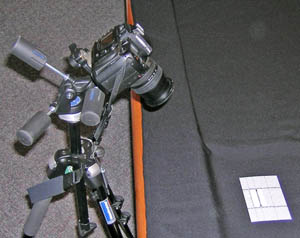
|
Try
to shoot with the center vertical line aligned with the camera vertical
line and the horizontal camera line perfectly lined up the horizontal
target line. The ends of the dark line on the target should
coincide
with the circle in the viewfinder. You should be clipping the left and
right edges of the target in the viewfinder.
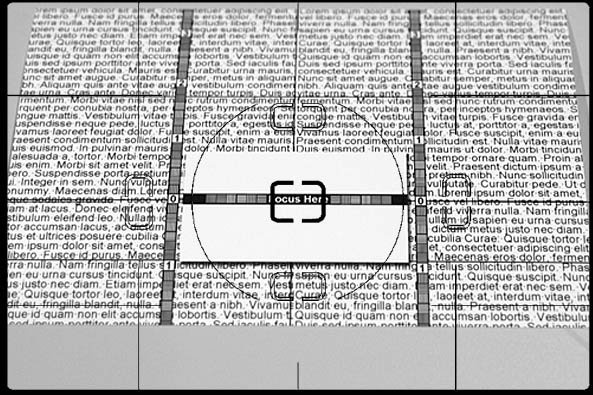
Take
a shot or two to observe proper exposure. The whites should be white
and the text should not be blown out. If there are light reflections or
shadows on the target, move things around until you get a clear, well
exposed shot over the whole image area.
Perform “The Move” as
described for the D70, but if you don’t have a
D70 figure out how to view an enlarged image on your monitor.
Learning
the
Move
In order to learn how to
conduct rapid checks you should learn this
little sequence until it becomes automatic.
| 1
Press the image display button. (Right Arrow Point on upper left of
viewing screen.) |

|
2
Immediately press the QUAL button and
|

|
| 3
press and hold the ISO button and |

|
| 4
roll the rear thumb wheel rapidly three times to the right. |
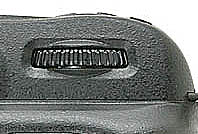
|
| 3.
Release the ISO button. The largest view of the image now appears on
the screen and the view is centered on the central focus area. |
|
|
|
This is called “The Move”
Evaluating what you see
You should be able to
read “Focus Here” if your picture was the Best
Little…..
You should be able to
see some geometric groups of white lines to the
left and right of “Focus Here”.
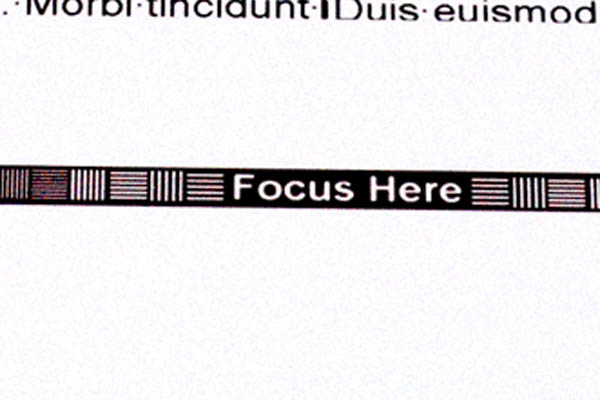
The first pattern is
horizontal lines and should be easily resolvable
on any lens. It consists of alternating bars of white and black which
are 3/320” thick. Each progressing pattern is either rotated 90 degrees
or one pixel smaller on the black and/or white bar. The finest pattern
is two black and two white, which is about the limit that you can see
on the viewfinder.
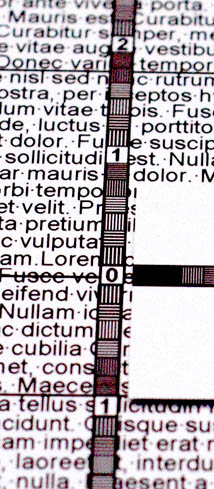 |
Tip
the 4 direction star pad to the left and view a similar pattern
progressing vertically. Each pattern group is numbered from zero on the
reference line and progressing up and down. The coarsest pattern is
next to zero in both directions. You should be able to see about the
same detail in the coarse pattern next to 1 on the bottom with the
coarse pattern next to 2 on the top. This approximates the depth of
field expected as 1/3 of the image before and 2/3 of the image beyond
the focal point. This is a mythical 1/3. Due to the very close focus
distance it may be more like ¼ or 1/5. How far you can go on
either
direction will depend on the f-stop of the lens taking the picture. (f
4 in this case)
Also on the target is a field of phony Latin text which you should not
try to translate, but observe the graying of the text and background as
the text is further from the focus point. |
In Peter Inova’s book on
the D70 and Digital photography he debunks
some myths and explains things that are commonly misunderstood. I
cannot quote because of copyright, but as he explains some of the
properties of hyper focal settings he suggests that the rule of thumb
of
1/3 of the image before and 2/3 after the ideal focal point are not
very accurate descriptions of what happens in real life. It may be
close to being true at great distances but as the focal point gets
closer it becomes more like ¼ and for really close things like
our target could be 1/5. I was very glad to find this out because it
was making me crazy trying to be true to the myth. What you want to
know is that the center of your focus is the sharpest at the correct
spot and that focus will more rapidly deteriorate on the close end.
This myth has caused many people in past to believe that they have a
back focus situation including the author of a very popular camera
forum. See a more detailed discussion in the FAQ section. Also read
about “What if my sensor does not align with the focus box I see in my
viewfinder.”
If you see what I just
described, rejoice! The camera and lens are
working perfectly.
If you are someone that
wants to manually focus the camera, you may
want to repeat the test again for ten repetitions with the auto focus
switch turned off. If this fails to give you consistent results, it may
or may not be the fault of the camera. We will discuss that in Part 2
or you can just forget about manual focus for a while.
If you are not satisfied
with the focus at this time go to Part 2.
Download
the
test
charts
Because these are bit
mapped images, they contain pure white and pure
black spaces and lend themselves to very efficient compression as TIFF
files using ZIP. The uncompressed TIFF file should be easily loaded
into
any of the newer image processors from Nikon, Canon or Adobe. Print
them as is. Do NOT sharpen or resize the targets or you will
alter the ability to hold resolution at the high end.
Click to download
Targets
Part
1: Is there something wrong with my camera?
Part
2: My camera is OK. Is there something wrong with my technique?
Part
3: My camera needs adjusting. Can I do it myself?
Part
4: Frequently asked questions and What if?
Part 5: Advanced
focus and lens analysis
Other references on focus procedures:
http://www.dpreview.com/reviews/nikond70/page19.asp
http://focustestchart.com
http://www.digitalsecrets.net/secrets/NikonD70.html
http://www.digitalsecrets.net
http://www.bythom.com
Thanks to Tim Jackson,
Phil Askey, Peter Inova and Thom Hogan for
educating me with their fine publications. Please visit their sites
listed above and help support their work.
|
|










